DB745 Business Project: Datacom Group Communication, Leadership Report
VerifiedAdded on 2023/06/11
|22
|5129
|436
Report
AI Summary
This report analyzes the effect of communication, leadership, and organizational culture on the business activities of Datacom Group. It begins with an executive summary and introduction, providing background information on Datacom, its objectives, and the scope of the research. The literature review explores organizational communication, leadership, and culture, drawing on various sources. The methodology section outlines the data collection methods, focusing on secondary data sources like books, journals, and websites. The report then presents a detailed data analysis, discussing the impact of communication, leadership styles, and workplace culture on Datacom's operations, revenue, and employee morale. The discussion section elaborates on these findings, followed by conclusions and recommendations for improving communication and leadership within the company. The report highlights the importance of effective communication, leadership, and a positive organizational culture in driving business success. It emphasizes the interconnectedness of these elements and their collective influence on Datacom's performance and growth.
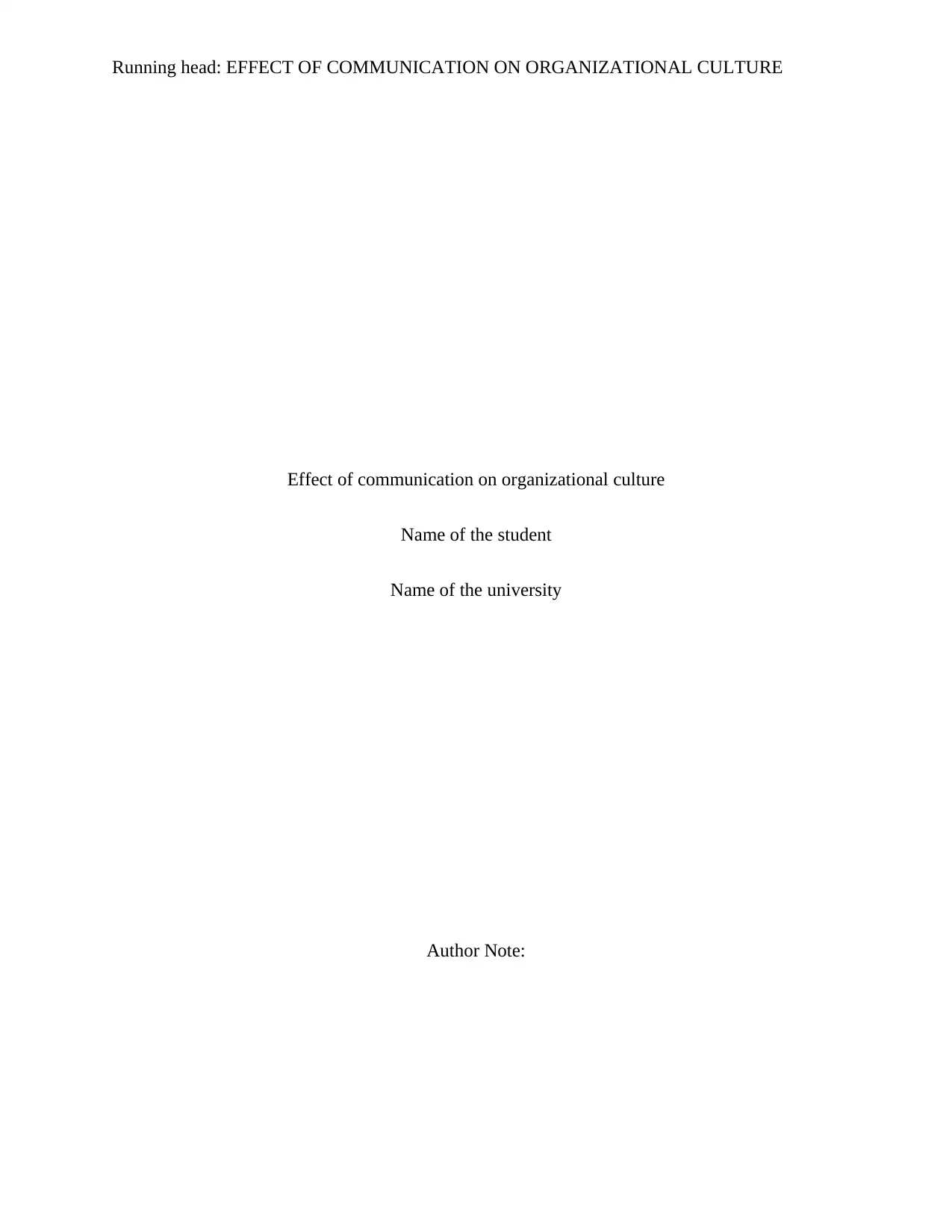
Running head: EFFECT OF COMMUNICATION ON ORGANIZATIONAL CULTURE
Effect of communication on organizational culture
Name of the student
Name of the university
Author Note:
Effect of communication on organizational culture
Name of the student
Name of the university
Author Note:
Paraphrase This Document
Need a fresh take? Get an instant paraphrase of this document with our AI Paraphraser
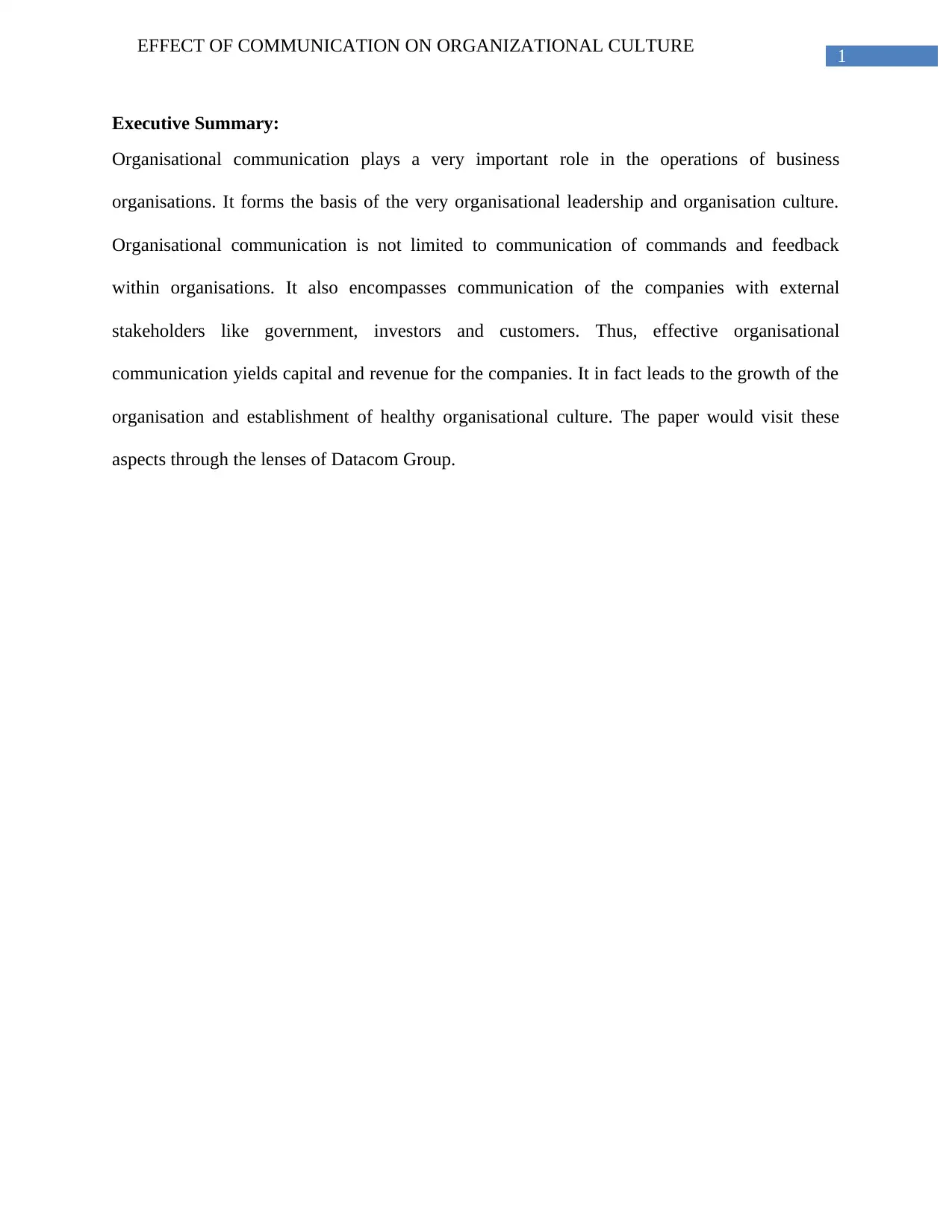
1
EFFECT OF COMMUNICATION ON ORGANIZATIONAL CULTURE
Executive Summary:
Organisational communication plays a very important role in the operations of business
organisations. It forms the basis of the very organisational leadership and organisation culture.
Organisational communication is not limited to communication of commands and feedback
within organisations. It also encompasses communication of the companies with external
stakeholders like government, investors and customers. Thus, effective organisational
communication yields capital and revenue for the companies. It in fact leads to the growth of the
organisation and establishment of healthy organisational culture. The paper would visit these
aspects through the lenses of Datacom Group.
EFFECT OF COMMUNICATION ON ORGANIZATIONAL CULTURE
Executive Summary:
Organisational communication plays a very important role in the operations of business
organisations. It forms the basis of the very organisational leadership and organisation culture.
Organisational communication is not limited to communication of commands and feedback
within organisations. It also encompasses communication of the companies with external
stakeholders like government, investors and customers. Thus, effective organisational
communication yields capital and revenue for the companies. It in fact leads to the growth of the
organisation and establishment of healthy organisational culture. The paper would visit these
aspects through the lenses of Datacom Group.
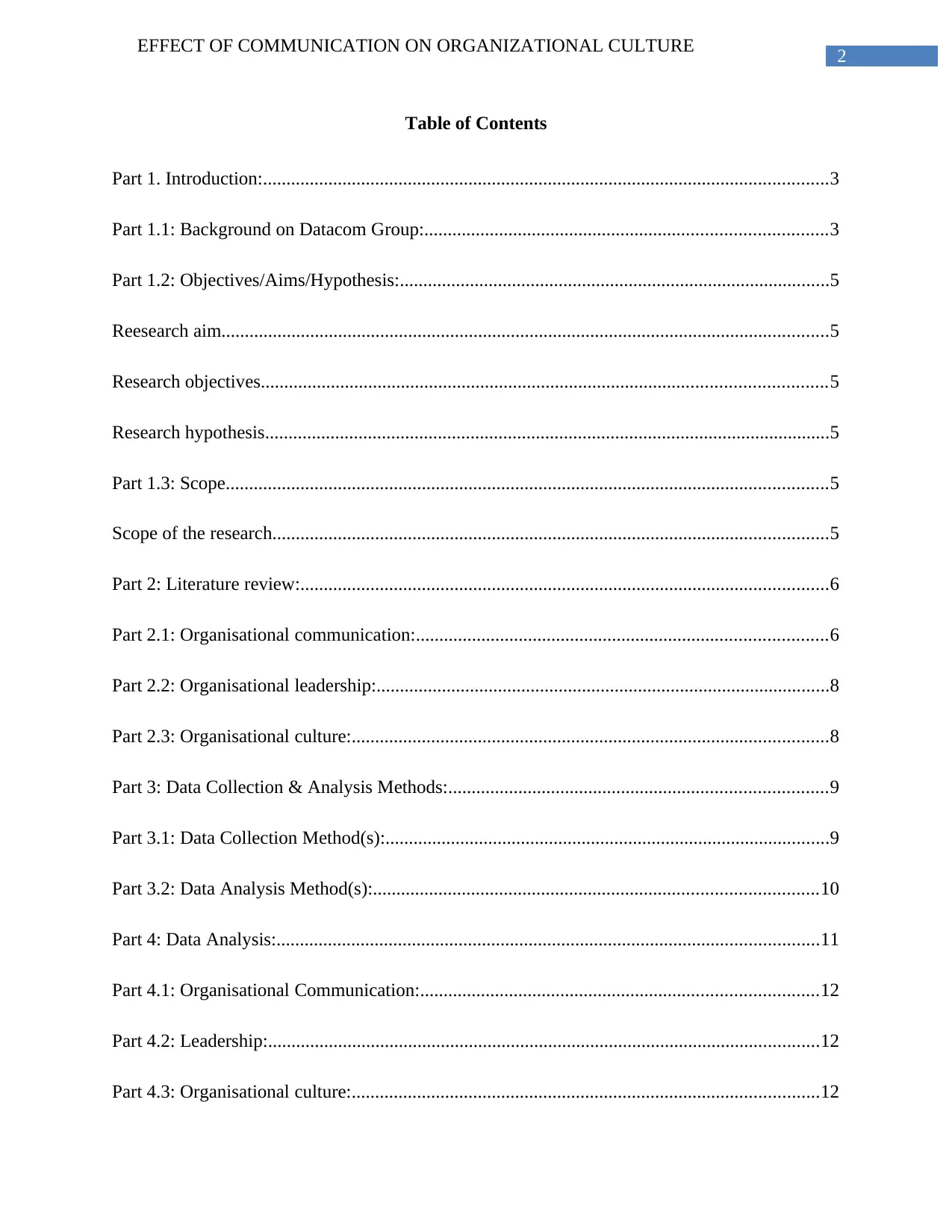
2
EFFECT OF COMMUNICATION ON ORGANIZATIONAL CULTURE
Table of Contents
Part 1. Introduction:.........................................................................................................................3
Part 1.1: Background on Datacom Group:......................................................................................3
Part 1.2: Objectives/Aims/Hypothesis:............................................................................................5
Reesearch aim..................................................................................................................................5
Research objectives.........................................................................................................................5
Research hypothesis.........................................................................................................................5
Part 1.3: Scope.................................................................................................................................5
Scope of the research.......................................................................................................................5
Part 2: Literature review:.................................................................................................................6
Part 2.1: Organisational communication:........................................................................................6
Part 2.2: Organisational leadership:.................................................................................................8
Part 2.3: Organisational culture:......................................................................................................8
Part 3: Data Collection & Analysis Methods:.................................................................................9
Part 3.1: Data Collection Method(s):...............................................................................................9
Part 3.2: Data Analysis Method(s):...............................................................................................10
Part 4: Data Analysis:....................................................................................................................11
Part 4.1: Organisational Communication:.....................................................................................12
Part 4.2: Leadership:......................................................................................................................12
Part 4.3: Organisational culture:....................................................................................................12
EFFECT OF COMMUNICATION ON ORGANIZATIONAL CULTURE
Table of Contents
Part 1. Introduction:.........................................................................................................................3
Part 1.1: Background on Datacom Group:......................................................................................3
Part 1.2: Objectives/Aims/Hypothesis:............................................................................................5
Reesearch aim..................................................................................................................................5
Research objectives.........................................................................................................................5
Research hypothesis.........................................................................................................................5
Part 1.3: Scope.................................................................................................................................5
Scope of the research.......................................................................................................................5
Part 2: Literature review:.................................................................................................................6
Part 2.1: Organisational communication:........................................................................................6
Part 2.2: Organisational leadership:.................................................................................................8
Part 2.3: Organisational culture:......................................................................................................8
Part 3: Data Collection & Analysis Methods:.................................................................................9
Part 3.1: Data Collection Method(s):...............................................................................................9
Part 3.2: Data Analysis Method(s):...............................................................................................10
Part 4: Data Analysis:....................................................................................................................11
Part 4.1: Organisational Communication:.....................................................................................12
Part 4.2: Leadership:......................................................................................................................12
Part 4.3: Organisational culture:....................................................................................................12
⊘ This is a preview!⊘
Do you want full access?
Subscribe today to unlock all pages.

Trusted by 1+ million students worldwide
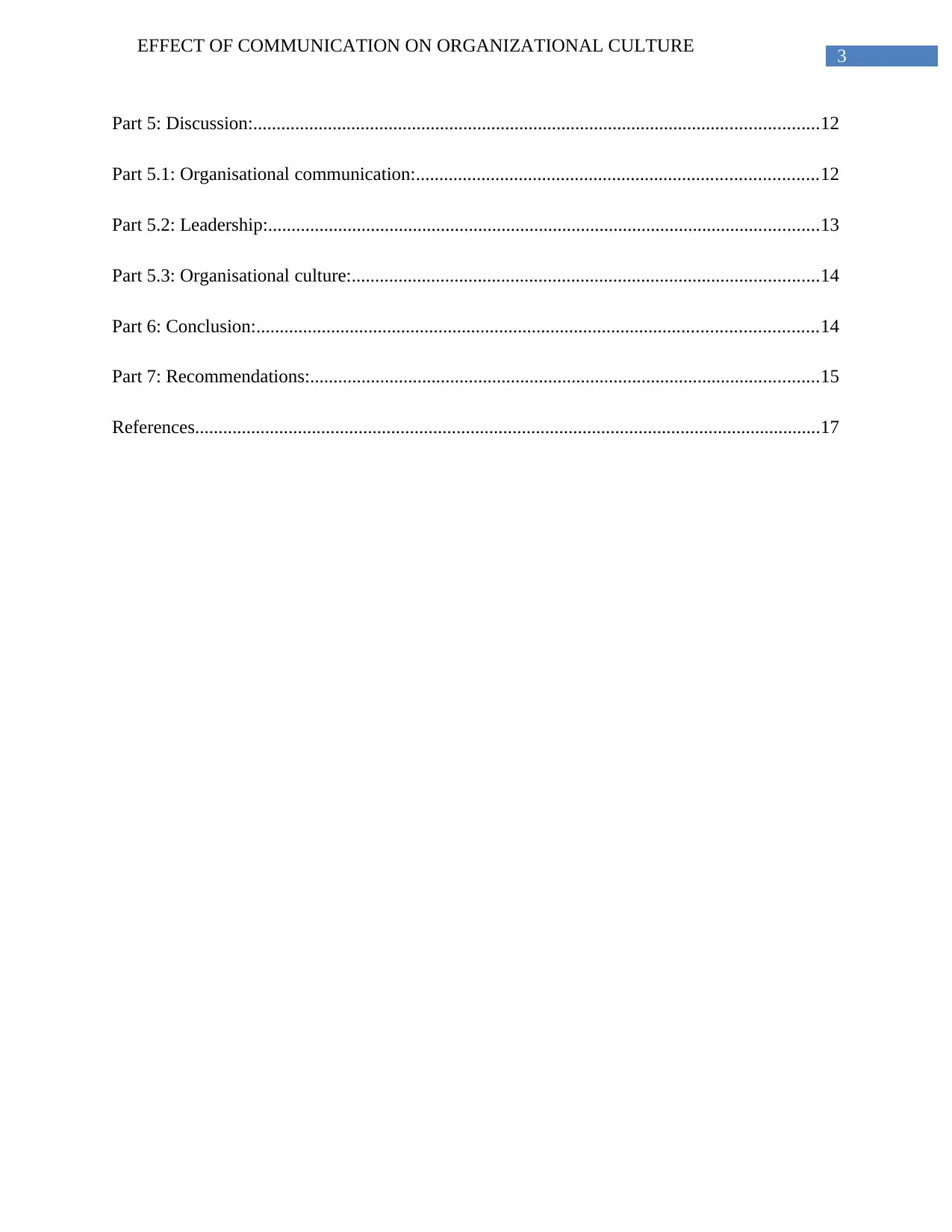
3
EFFECT OF COMMUNICATION ON ORGANIZATIONAL CULTURE
Part 5: Discussion:.........................................................................................................................12
Part 5.1: Organisational communication:......................................................................................12
Part 5.2: Leadership:......................................................................................................................13
Part 5.3: Organisational culture:....................................................................................................14
Part 6: Conclusion:........................................................................................................................14
Part 7: Recommendations:.............................................................................................................15
References......................................................................................................................................17
EFFECT OF COMMUNICATION ON ORGANIZATIONAL CULTURE
Part 5: Discussion:.........................................................................................................................12
Part 5.1: Organisational communication:......................................................................................12
Part 5.2: Leadership:......................................................................................................................13
Part 5.3: Organisational culture:....................................................................................................14
Part 6: Conclusion:........................................................................................................................14
Part 7: Recommendations:.............................................................................................................15
References......................................................................................................................................17
Paraphrase This Document
Need a fresh take? Get an instant paraphrase of this document with our AI Paraphraser
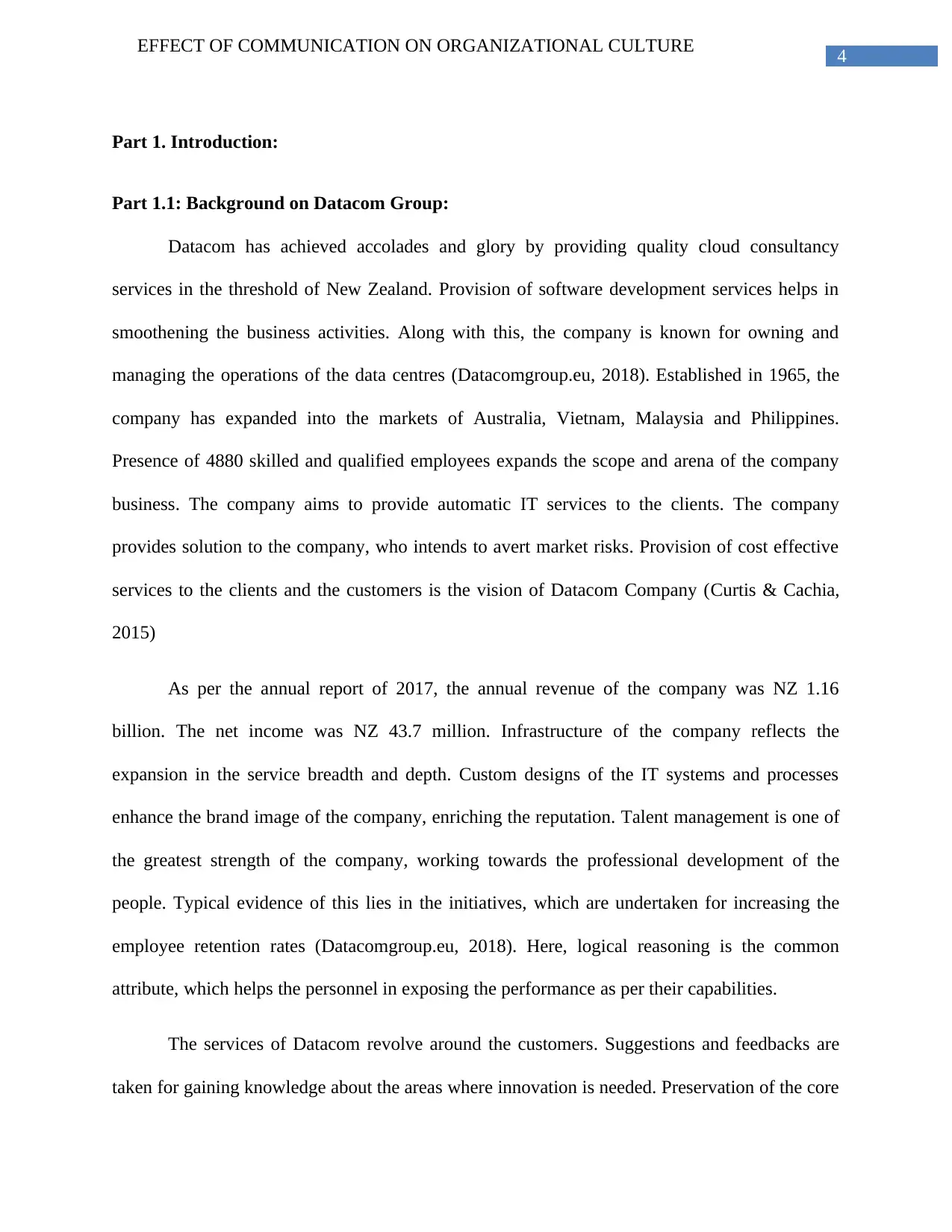
4
EFFECT OF COMMUNICATION ON ORGANIZATIONAL CULTURE
Part 1. Introduction:
Part 1.1: Background on Datacom Group:
Datacom has achieved accolades and glory by providing quality cloud consultancy
services in the threshold of New Zealand. Provision of software development services helps in
smoothening the business activities. Along with this, the company is known for owning and
managing the operations of the data centres (Datacomgroup.eu, 2018). Established in 1965, the
company has expanded into the markets of Australia, Vietnam, Malaysia and Philippines.
Presence of 4880 skilled and qualified employees expands the scope and arena of the company
business. The company aims to provide automatic IT services to the clients. The company
provides solution to the company, who intends to avert market risks. Provision of cost effective
services to the clients and the customers is the vision of Datacom Company (Curtis & Cachia,
2015)
As per the annual report of 2017, the annual revenue of the company was NZ 1.16
billion. The net income was NZ 43.7 million. Infrastructure of the company reflects the
expansion in the service breadth and depth. Custom designs of the IT systems and processes
enhance the brand image of the company, enriching the reputation. Talent management is one of
the greatest strength of the company, working towards the professional development of the
people. Typical evidence of this lies in the initiatives, which are undertaken for increasing the
employee retention rates (Datacomgroup.eu, 2018). Here, logical reasoning is the common
attribute, which helps the personnel in exposing the performance as per their capabilities.
The services of Datacom revolve around the customers. Suggestions and feedbacks are
taken for gaining knowledge about the areas where innovation is needed. Preservation of the core
EFFECT OF COMMUNICATION ON ORGANIZATIONAL CULTURE
Part 1. Introduction:
Part 1.1: Background on Datacom Group:
Datacom has achieved accolades and glory by providing quality cloud consultancy
services in the threshold of New Zealand. Provision of software development services helps in
smoothening the business activities. Along with this, the company is known for owning and
managing the operations of the data centres (Datacomgroup.eu, 2018). Established in 1965, the
company has expanded into the markets of Australia, Vietnam, Malaysia and Philippines.
Presence of 4880 skilled and qualified employees expands the scope and arena of the company
business. The company aims to provide automatic IT services to the clients. The company
provides solution to the company, who intends to avert market risks. Provision of cost effective
services to the clients and the customers is the vision of Datacom Company (Curtis & Cachia,
2015)
As per the annual report of 2017, the annual revenue of the company was NZ 1.16
billion. The net income was NZ 43.7 million. Infrastructure of the company reflects the
expansion in the service breadth and depth. Custom designs of the IT systems and processes
enhance the brand image of the company, enriching the reputation. Talent management is one of
the greatest strength of the company, working towards the professional development of the
people. Typical evidence of this lies in the initiatives, which are undertaken for increasing the
employee retention rates (Datacomgroup.eu, 2018). Here, logical reasoning is the common
attribute, which helps the personnel in exposing the performance as per their capabilities.
The services of Datacom revolve around the customers. Suggestions and feedbacks are
taken for gaining knowledge about the areas where innovation is needed. Preservation of the core
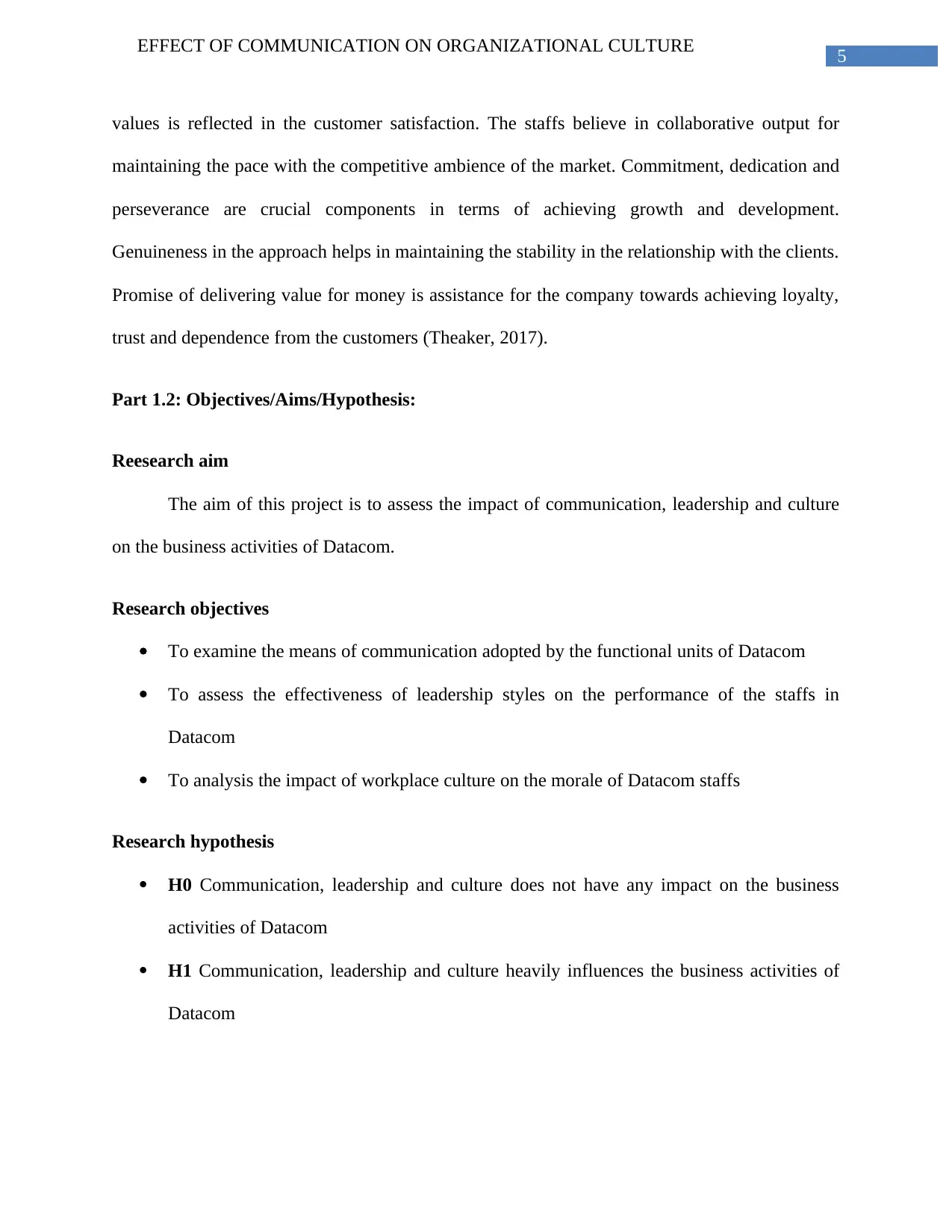
5
EFFECT OF COMMUNICATION ON ORGANIZATIONAL CULTURE
values is reflected in the customer satisfaction. The staffs believe in collaborative output for
maintaining the pace with the competitive ambience of the market. Commitment, dedication and
perseverance are crucial components in terms of achieving growth and development.
Genuineness in the approach helps in maintaining the stability in the relationship with the clients.
Promise of delivering value for money is assistance for the company towards achieving loyalty,
trust and dependence from the customers (Theaker, 2017).
Part 1.2: Objectives/Aims/Hypothesis:
Reesearch aim
The aim of this project is to assess the impact of communication, leadership and culture
on the business activities of Datacom.
Research objectives
To examine the means of communication adopted by the functional units of Datacom
To assess the effectiveness of leadership styles on the performance of the staffs in
Datacom
To analysis the impact of workplace culture on the morale of Datacom staffs
Research hypothesis
H0 Communication, leadership and culture does not have any impact on the business
activities of Datacom
H1 Communication, leadership and culture heavily influences the business activities of
Datacom
EFFECT OF COMMUNICATION ON ORGANIZATIONAL CULTURE
values is reflected in the customer satisfaction. The staffs believe in collaborative output for
maintaining the pace with the competitive ambience of the market. Commitment, dedication and
perseverance are crucial components in terms of achieving growth and development.
Genuineness in the approach helps in maintaining the stability in the relationship with the clients.
Promise of delivering value for money is assistance for the company towards achieving loyalty,
trust and dependence from the customers (Theaker, 2017).
Part 1.2: Objectives/Aims/Hypothesis:
Reesearch aim
The aim of this project is to assess the impact of communication, leadership and culture
on the business activities of Datacom.
Research objectives
To examine the means of communication adopted by the functional units of Datacom
To assess the effectiveness of leadership styles on the performance of the staffs in
Datacom
To analysis the impact of workplace culture on the morale of Datacom staffs
Research hypothesis
H0 Communication, leadership and culture does not have any impact on the business
activities of Datacom
H1 Communication, leadership and culture heavily influences the business activities of
Datacom
⊘ This is a preview!⊘
Do you want full access?
Subscribe today to unlock all pages.

Trusted by 1+ million students worldwide
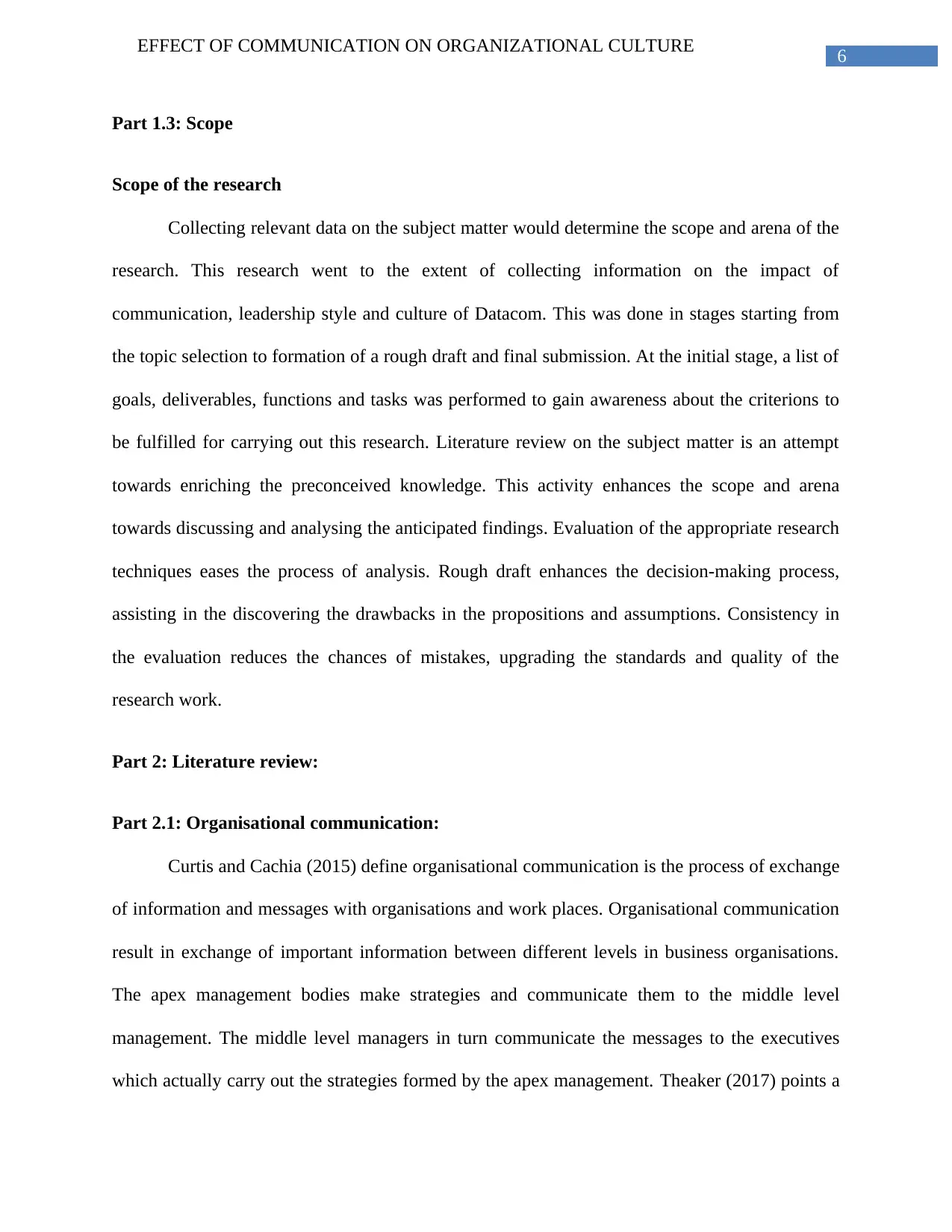
6
EFFECT OF COMMUNICATION ON ORGANIZATIONAL CULTURE
Part 1.3: Scope
Scope of the research
Collecting relevant data on the subject matter would determine the scope and arena of the
research. This research went to the extent of collecting information on the impact of
communication, leadership style and culture of Datacom. This was done in stages starting from
the topic selection to formation of a rough draft and final submission. At the initial stage, a list of
goals, deliverables, functions and tasks was performed to gain awareness about the criterions to
be fulfilled for carrying out this research. Literature review on the subject matter is an attempt
towards enriching the preconceived knowledge. This activity enhances the scope and arena
towards discussing and analysing the anticipated findings. Evaluation of the appropriate research
techniques eases the process of analysis. Rough draft enhances the decision-making process,
assisting in the discovering the drawbacks in the propositions and assumptions. Consistency in
the evaluation reduces the chances of mistakes, upgrading the standards and quality of the
research work.
Part 2: Literature review:
Part 2.1: Organisational communication:
Curtis and Cachia (2015) define organisational communication is the process of exchange
of information and messages with organisations and work places. Organisational communication
result in exchange of important information between different levels in business organisations.
The apex management bodies make strategies and communicate them to the middle level
management. The middle level managers in turn communicate the messages to the executives
which actually carry out the strategies formed by the apex management. Theaker (2017) points a
EFFECT OF COMMUNICATION ON ORGANIZATIONAL CULTURE
Part 1.3: Scope
Scope of the research
Collecting relevant data on the subject matter would determine the scope and arena of the
research. This research went to the extent of collecting information on the impact of
communication, leadership style and culture of Datacom. This was done in stages starting from
the topic selection to formation of a rough draft and final submission. At the initial stage, a list of
goals, deliverables, functions and tasks was performed to gain awareness about the criterions to
be fulfilled for carrying out this research. Literature review on the subject matter is an attempt
towards enriching the preconceived knowledge. This activity enhances the scope and arena
towards discussing and analysing the anticipated findings. Evaluation of the appropriate research
techniques eases the process of analysis. Rough draft enhances the decision-making process,
assisting in the discovering the drawbacks in the propositions and assumptions. Consistency in
the evaluation reduces the chances of mistakes, upgrading the standards and quality of the
research work.
Part 2: Literature review:
Part 2.1: Organisational communication:
Curtis and Cachia (2015) define organisational communication is the process of exchange
of information and messages with organisations and work places. Organisational communication
result in exchange of important information between different levels in business organisations.
The apex management bodies make strategies and communicate them to the middle level
management. The middle level managers in turn communicate the messages to the executives
which actually carry out the strategies formed by the apex management. Theaker (2017) points a
Paraphrase This Document
Need a fresh take? Get an instant paraphrase of this document with our AI Paraphraser
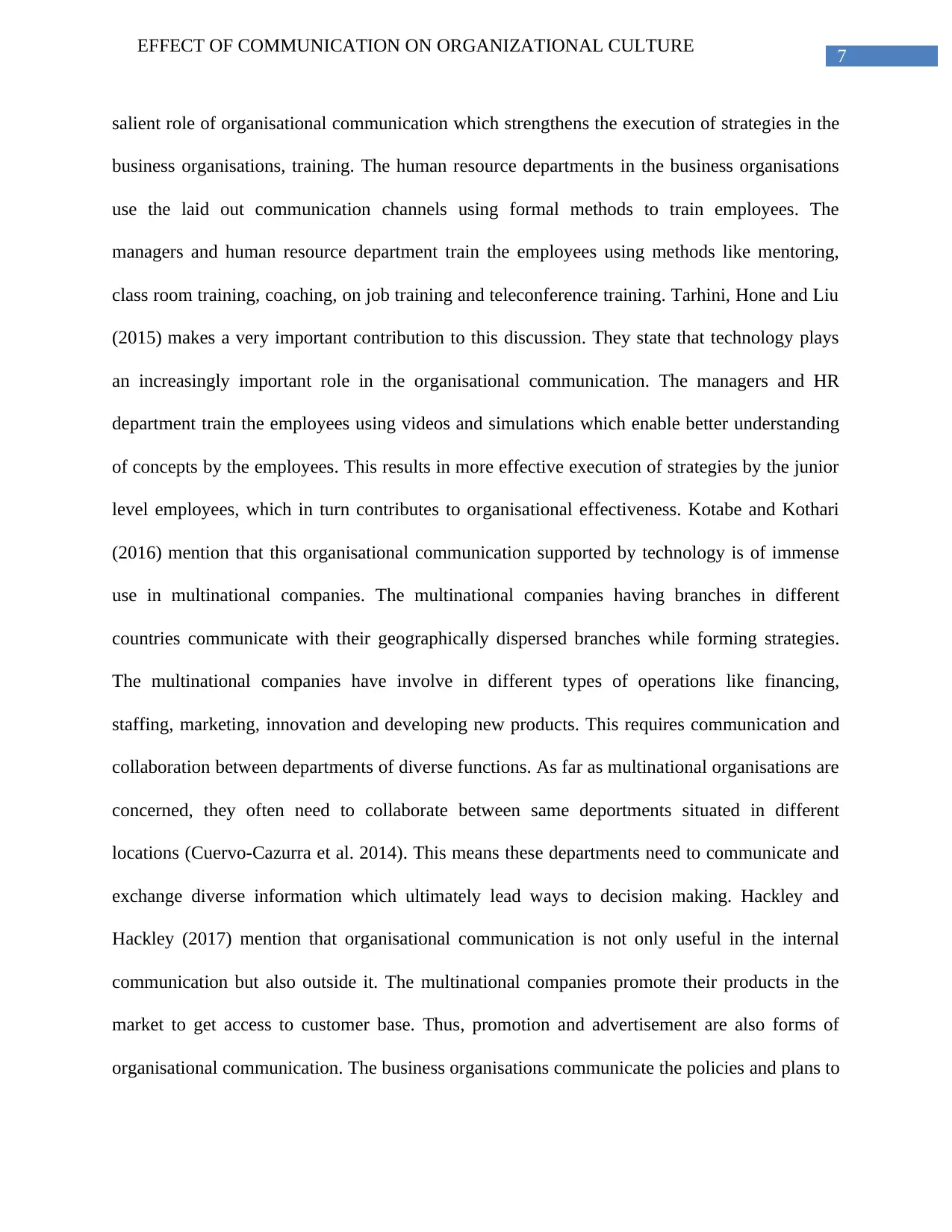
7
EFFECT OF COMMUNICATION ON ORGANIZATIONAL CULTURE
salient role of organisational communication which strengthens the execution of strategies in the
business organisations, training. The human resource departments in the business organisations
use the laid out communication channels using formal methods to train employees. The
managers and human resource department train the employees using methods like mentoring,
class room training, coaching, on job training and teleconference training. Tarhini, Hone and Liu
(2015) makes a very important contribution to this discussion. They state that technology plays
an increasingly important role in the organisational communication. The managers and HR
department train the employees using videos and simulations which enable better understanding
of concepts by the employees. This results in more effective execution of strategies by the junior
level employees, which in turn contributes to organisational effectiveness. Kotabe and Kothari
(2016) mention that this organisational communication supported by technology is of immense
use in multinational companies. The multinational companies having branches in different
countries communicate with their geographically dispersed branches while forming strategies.
The multinational companies have involve in different types of operations like financing,
staffing, marketing, innovation and developing new products. This requires communication and
collaboration between departments of diverse functions. As far as multinational organisations are
concerned, they often need to collaborate between same deportments situated in different
locations (Cuervo-Cazurra et al. 2014). This means these departments need to communicate and
exchange diverse information which ultimately lead ways to decision making. Hackley and
Hackley (2017) mention that organisational communication is not only useful in the internal
communication but also outside it. The multinational companies promote their products in the
market to get access to customer base. Thus, promotion and advertisement are also forms of
organisational communication. The business organisations communicate the policies and plans to
EFFECT OF COMMUNICATION ON ORGANIZATIONAL CULTURE
salient role of organisational communication which strengthens the execution of strategies in the
business organisations, training. The human resource departments in the business organisations
use the laid out communication channels using formal methods to train employees. The
managers and human resource department train the employees using methods like mentoring,
class room training, coaching, on job training and teleconference training. Tarhini, Hone and Liu
(2015) makes a very important contribution to this discussion. They state that technology plays
an increasingly important role in the organisational communication. The managers and HR
department train the employees using videos and simulations which enable better understanding
of concepts by the employees. This results in more effective execution of strategies by the junior
level employees, which in turn contributes to organisational effectiveness. Kotabe and Kothari
(2016) mention that this organisational communication supported by technology is of immense
use in multinational companies. The multinational companies having branches in different
countries communicate with their geographically dispersed branches while forming strategies.
The multinational companies have involve in different types of operations like financing,
staffing, marketing, innovation and developing new products. This requires communication and
collaboration between departments of diverse functions. As far as multinational organisations are
concerned, they often need to collaborate between same deportments situated in different
locations (Cuervo-Cazurra et al. 2014). This means these departments need to communicate and
exchange diverse information which ultimately lead ways to decision making. Hackley and
Hackley (2017) mention that organisational communication is not only useful in the internal
communication but also outside it. The multinational companies promote their products in the
market to get access to customer base. Thus, promotion and advertisement are also forms of
organisational communication. The business organisations communicate the policies and plans to
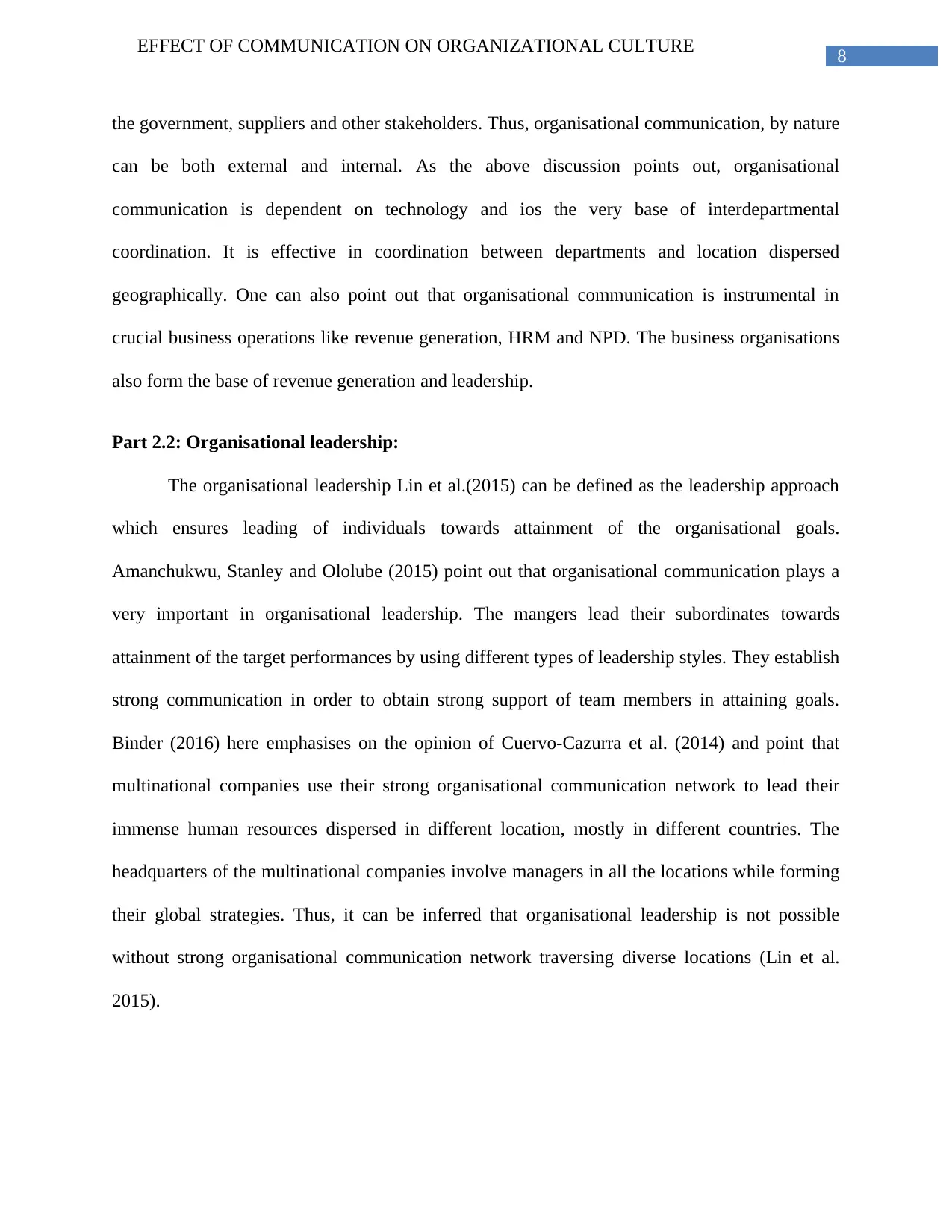
8
EFFECT OF COMMUNICATION ON ORGANIZATIONAL CULTURE
the government, suppliers and other stakeholders. Thus, organisational communication, by nature
can be both external and internal. As the above discussion points out, organisational
communication is dependent on technology and ios the very base of interdepartmental
coordination. It is effective in coordination between departments and location dispersed
geographically. One can also point out that organisational communication is instrumental in
crucial business operations like revenue generation, HRM and NPD. The business organisations
also form the base of revenue generation and leadership.
Part 2.2: Organisational leadership:
The organisational leadership Lin et al.(2015) can be defined as the leadership approach
which ensures leading of individuals towards attainment of the organisational goals.
Amanchukwu, Stanley and Ololube (2015) point out that organisational communication plays a
very important in organisational leadership. The mangers lead their subordinates towards
attainment of the target performances by using different types of leadership styles. They establish
strong communication in order to obtain strong support of team members in attaining goals.
Binder (2016) here emphasises on the opinion of Cuervo-Cazurra et al. (2014) and point that
multinational companies use their strong organisational communication network to lead their
immense human resources dispersed in different location, mostly in different countries. The
headquarters of the multinational companies involve managers in all the locations while forming
their global strategies. Thus, it can be inferred that organisational leadership is not possible
without strong organisational communication network traversing diverse locations (Lin et al.
2015).
EFFECT OF COMMUNICATION ON ORGANIZATIONAL CULTURE
the government, suppliers and other stakeholders. Thus, organisational communication, by nature
can be both external and internal. As the above discussion points out, organisational
communication is dependent on technology and ios the very base of interdepartmental
coordination. It is effective in coordination between departments and location dispersed
geographically. One can also point out that organisational communication is instrumental in
crucial business operations like revenue generation, HRM and NPD. The business organisations
also form the base of revenue generation and leadership.
Part 2.2: Organisational leadership:
The organisational leadership Lin et al.(2015) can be defined as the leadership approach
which ensures leading of individuals towards attainment of the organisational goals.
Amanchukwu, Stanley and Ololube (2015) point out that organisational communication plays a
very important in organisational leadership. The mangers lead their subordinates towards
attainment of the target performances by using different types of leadership styles. They establish
strong communication in order to obtain strong support of team members in attaining goals.
Binder (2016) here emphasises on the opinion of Cuervo-Cazurra et al. (2014) and point that
multinational companies use their strong organisational communication network to lead their
immense human resources dispersed in different location, mostly in different countries. The
headquarters of the multinational companies involve managers in all the locations while forming
their global strategies. Thus, it can be inferred that organisational leadership is not possible
without strong organisational communication network traversing diverse locations (Lin et al.
2015).
⊘ This is a preview!⊘
Do you want full access?
Subscribe today to unlock all pages.

Trusted by 1+ million students worldwide
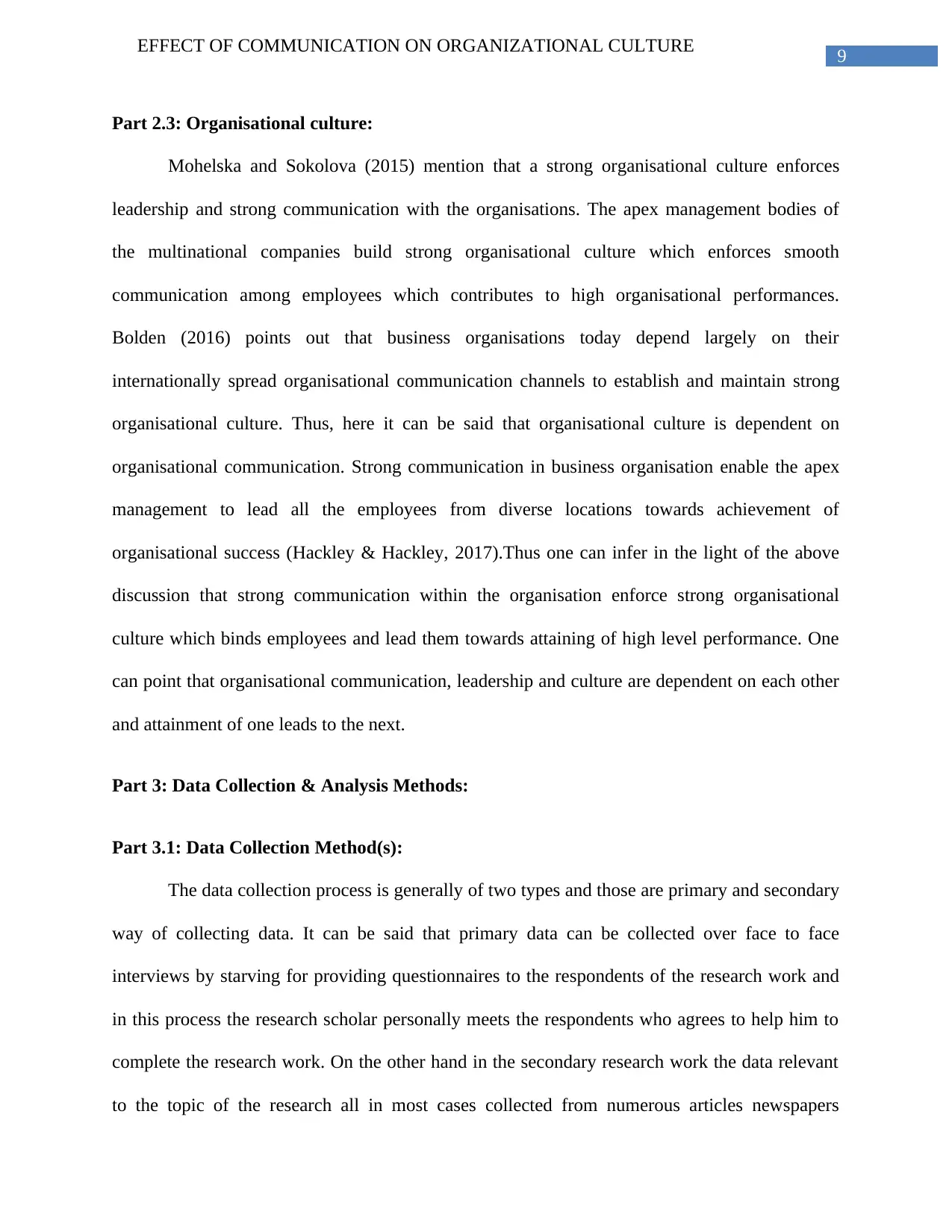
9
EFFECT OF COMMUNICATION ON ORGANIZATIONAL CULTURE
Part 2.3: Organisational culture:
Mohelska and Sokolova (2015) mention that a strong organisational culture enforces
leadership and strong communication with the organisations. The apex management bodies of
the multinational companies build strong organisational culture which enforces smooth
communication among employees which contributes to high organisational performances.
Bolden (2016) points out that business organisations today depend largely on their
internationally spread organisational communication channels to establish and maintain strong
organisational culture. Thus, here it can be said that organisational culture is dependent on
organisational communication. Strong communication in business organisation enable the apex
management to lead all the employees from diverse locations towards achievement of
organisational success (Hackley & Hackley, 2017).Thus one can infer in the light of the above
discussion that strong communication within the organisation enforce strong organisational
culture which binds employees and lead them towards attaining of high level performance. One
can point that organisational communication, leadership and culture are dependent on each other
and attainment of one leads to the next.
Part 3: Data Collection & Analysis Methods:
Part 3.1: Data Collection Method(s):
The data collection process is generally of two types and those are primary and secondary
way of collecting data. It can be said that primary data can be collected over face to face
interviews by starving for providing questionnaires to the respondents of the research work and
in this process the research scholar personally meets the respondents who agrees to help him to
complete the research work. On the other hand in the secondary research work the data relevant
to the topic of the research all in most cases collected from numerous articles newspapers
EFFECT OF COMMUNICATION ON ORGANIZATIONAL CULTURE
Part 2.3: Organisational culture:
Mohelska and Sokolova (2015) mention that a strong organisational culture enforces
leadership and strong communication with the organisations. The apex management bodies of
the multinational companies build strong organisational culture which enforces smooth
communication among employees which contributes to high organisational performances.
Bolden (2016) points out that business organisations today depend largely on their
internationally spread organisational communication channels to establish and maintain strong
organisational culture. Thus, here it can be said that organisational culture is dependent on
organisational communication. Strong communication in business organisation enable the apex
management to lead all the employees from diverse locations towards achievement of
organisational success (Hackley & Hackley, 2017).Thus one can infer in the light of the above
discussion that strong communication within the organisation enforce strong organisational
culture which binds employees and lead them towards attaining of high level performance. One
can point that organisational communication, leadership and culture are dependent on each other
and attainment of one leads to the next.
Part 3: Data Collection & Analysis Methods:
Part 3.1: Data Collection Method(s):
The data collection process is generally of two types and those are primary and secondary
way of collecting data. It can be said that primary data can be collected over face to face
interviews by starving for providing questionnaires to the respondents of the research work and
in this process the research scholar personally meets the respondents who agrees to help him to
complete the research work. On the other hand in the secondary research work the data relevant
to the topic of the research all in most cases collected from numerous articles newspapers
Paraphrase This Document
Need a fresh take? Get an instant paraphrase of this document with our AI Paraphraser
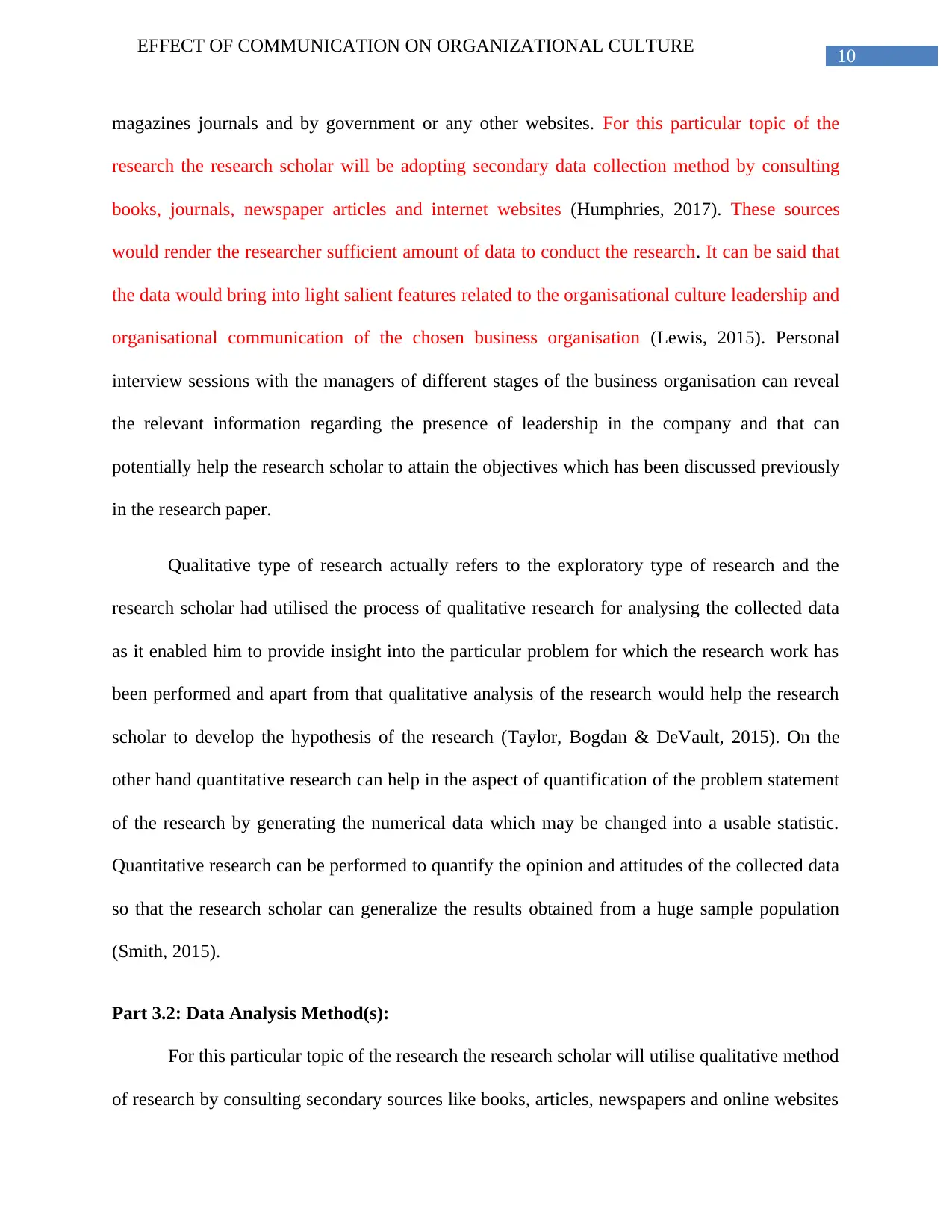
10
EFFECT OF COMMUNICATION ON ORGANIZATIONAL CULTURE
magazines journals and by government or any other websites. For this particular topic of the
research the research scholar will be adopting secondary data collection method by consulting
books, journals, newspaper articles and internet websites (Humphries, 2017). These sources
would render the researcher sufficient amount of data to conduct the research. It can be said that
the data would bring into light salient features related to the organisational culture leadership and
organisational communication of the chosen business organisation (Lewis, 2015). Personal
interview sessions with the managers of different stages of the business organisation can reveal
the relevant information regarding the presence of leadership in the company and that can
potentially help the research scholar to attain the objectives which has been discussed previously
in the research paper.
Qualitative type of research actually refers to the exploratory type of research and the
research scholar had utilised the process of qualitative research for analysing the collected data
as it enabled him to provide insight into the particular problem for which the research work has
been performed and apart from that qualitative analysis of the research would help the research
scholar to develop the hypothesis of the research (Taylor, Bogdan & DeVault, 2015). On the
other hand quantitative research can help in the aspect of quantification of the problem statement
of the research by generating the numerical data which may be changed into a usable statistic.
Quantitative research can be performed to quantify the opinion and attitudes of the collected data
so that the research scholar can generalize the results obtained from a huge sample population
(Smith, 2015).
Part 3.2: Data Analysis Method(s):
For this particular topic of the research the research scholar will utilise qualitative method
of research by consulting secondary sources like books, articles, newspapers and online websites
EFFECT OF COMMUNICATION ON ORGANIZATIONAL CULTURE
magazines journals and by government or any other websites. For this particular topic of the
research the research scholar will be adopting secondary data collection method by consulting
books, journals, newspaper articles and internet websites (Humphries, 2017). These sources
would render the researcher sufficient amount of data to conduct the research. It can be said that
the data would bring into light salient features related to the organisational culture leadership and
organisational communication of the chosen business organisation (Lewis, 2015). Personal
interview sessions with the managers of different stages of the business organisation can reveal
the relevant information regarding the presence of leadership in the company and that can
potentially help the research scholar to attain the objectives which has been discussed previously
in the research paper.
Qualitative type of research actually refers to the exploratory type of research and the
research scholar had utilised the process of qualitative research for analysing the collected data
as it enabled him to provide insight into the particular problem for which the research work has
been performed and apart from that qualitative analysis of the research would help the research
scholar to develop the hypothesis of the research (Taylor, Bogdan & DeVault, 2015). On the
other hand quantitative research can help in the aspect of quantification of the problem statement
of the research by generating the numerical data which may be changed into a usable statistic.
Quantitative research can be performed to quantify the opinion and attitudes of the collected data
so that the research scholar can generalize the results obtained from a huge sample population
(Smith, 2015).
Part 3.2: Data Analysis Method(s):
For this particular topic of the research the research scholar will utilise qualitative method
of research by consulting secondary sources like books, articles, newspapers and online websites
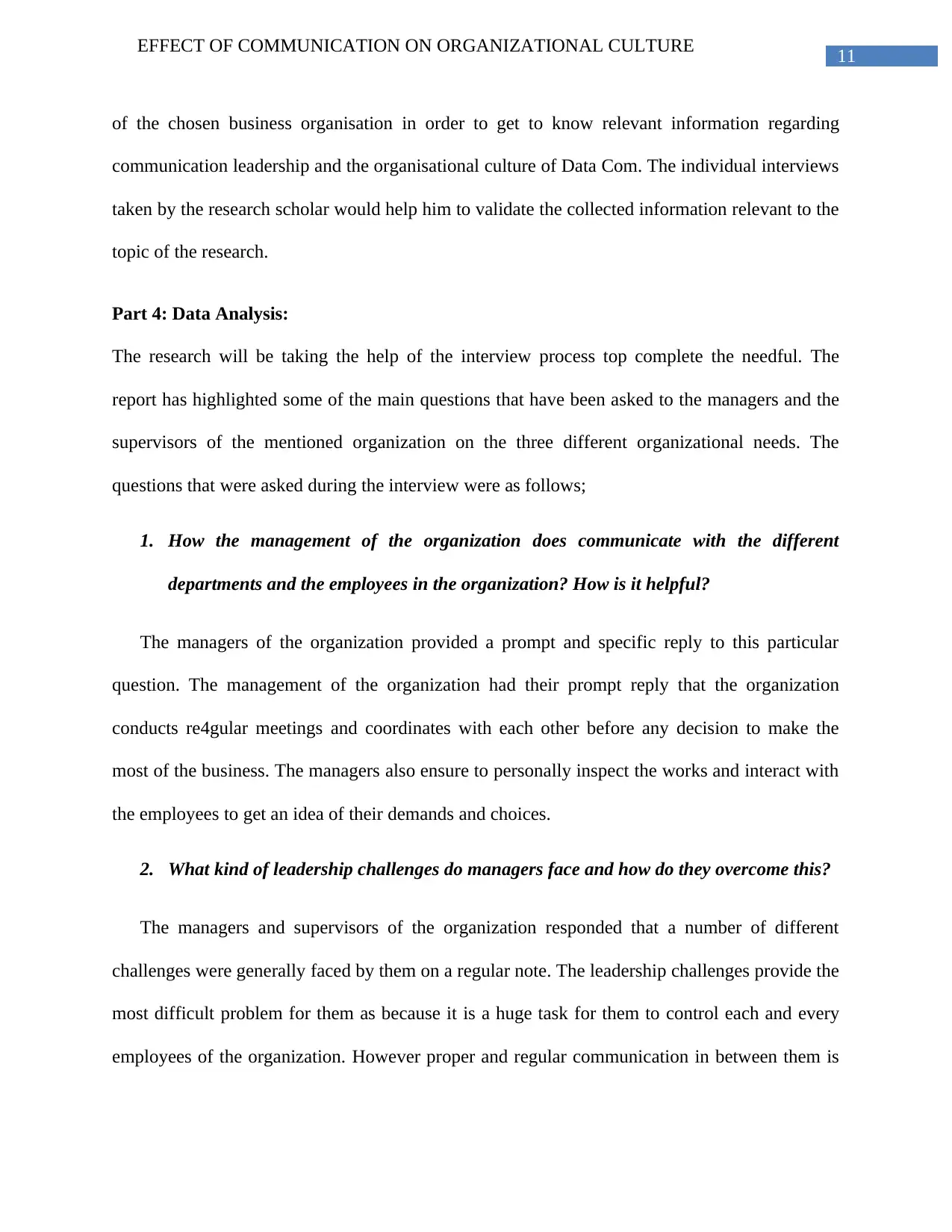
11
EFFECT OF COMMUNICATION ON ORGANIZATIONAL CULTURE
of the chosen business organisation in order to get to know relevant information regarding
communication leadership and the organisational culture of Data Com. The individual interviews
taken by the research scholar would help him to validate the collected information relevant to the
topic of the research.
Part 4: Data Analysis:
The research will be taking the help of the interview process top complete the needful. The
report has highlighted some of the main questions that have been asked to the managers and the
supervisors of the mentioned organization on the three different organizational needs. The
questions that were asked during the interview were as follows;
1. How the management of the organization does communicate with the different
departments and the employees in the organization? How is it helpful?
The managers of the organization provided a prompt and specific reply to this particular
question. The management of the organization had their prompt reply that the organization
conducts re4gular meetings and coordinates with each other before any decision to make the
most of the business. The managers also ensure to personally inspect the works and interact with
the employees to get an idea of their demands and choices.
2. What kind of leadership challenges do managers face and how do they overcome this?
The managers and supervisors of the organization responded that a number of different
challenges were generally faced by them on a regular note. The leadership challenges provide the
most difficult problem for them as because it is a huge task for them to control each and every
employees of the organization. However proper and regular communication in between them is
EFFECT OF COMMUNICATION ON ORGANIZATIONAL CULTURE
of the chosen business organisation in order to get to know relevant information regarding
communication leadership and the organisational culture of Data Com. The individual interviews
taken by the research scholar would help him to validate the collected information relevant to the
topic of the research.
Part 4: Data Analysis:
The research will be taking the help of the interview process top complete the needful. The
report has highlighted some of the main questions that have been asked to the managers and the
supervisors of the mentioned organization on the three different organizational needs. The
questions that were asked during the interview were as follows;
1. How the management of the organization does communicate with the different
departments and the employees in the organization? How is it helpful?
The managers of the organization provided a prompt and specific reply to this particular
question. The management of the organization had their prompt reply that the organization
conducts re4gular meetings and coordinates with each other before any decision to make the
most of the business. The managers also ensure to personally inspect the works and interact with
the employees to get an idea of their demands and choices.
2. What kind of leadership challenges do managers face and how do they overcome this?
The managers and supervisors of the organization responded that a number of different
challenges were generally faced by them on a regular note. The leadership challenges provide the
most difficult problem for them as because it is a huge task for them to control each and every
employees of the organization. However proper and regular communication in between them is
⊘ This is a preview!⊘
Do you want full access?
Subscribe today to unlock all pages.

Trusted by 1+ million students worldwide
1 out of 22
Related Documents
Your All-in-One AI-Powered Toolkit for Academic Success.
+13062052269
info@desklib.com
Available 24*7 on WhatsApp / Email
![[object Object]](/_next/static/media/star-bottom.7253800d.svg)
Unlock your academic potential
Copyright © 2020–2025 A2Z Services. All Rights Reserved. Developed and managed by ZUCOL.



